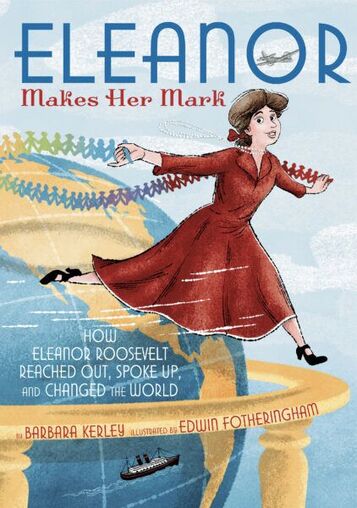By Mary Ann Cappiello and Jenn Sanders, on behalf of The Biography Clearinghouse  “The purpose of life, after all, is to live it, to taste experience to the utmost, to reach out eagerly and without fear.” This quote greets readers of Barbara Kerley and Edwin Fotheringham’s latest collaboration, Eleanor Makes Her Mark: How Eleanor Roosevelt Reached Out, Spoke Up, and Changed the World. Kerley drops her readers right into the busy preparations for Franklin Delano Roosevelt’s first inauguration, grounding readers in Eleanor’s public identity as the forthcoming First Lady. But then Kerley brings the readers back in time to Eleanor’s unhappy childhood and early adolescent years. Kerley’s characterization of Eleanor builds across the text: shy and quiet girl, engaged intellectual, socialite seeking purpose by teaching calisthenics in settlement houses and researching working conditions in garment factories, and, ultimately First Lady of the United States. As First Lady, Eleanor’s travels continued around the United States and across the Globe as she investigated working conditions, discrimination, and the effects of the devastation of The Great Depression and World War II. Kerley concludes the biography with Eleanor’s position as delegate to the newly formed United States General Assembly, working on the committee that authored the Universal Declaration of Human Rights. Throughout the book, illustrator Edwin Fotheringam works with visual metaphors to emphasize Eleanor’s unflagging energy and her ability to bring people together. In the cover illustration, Eleanor jumps off of a globe, streaming a banner of paper dolls holding hands that trails in her wake. Fotheringham peppers the book with swirling lines of motion, highlighting Eleanor’s boundless verve, vivacity, and constant travel. Fotheringham also continues the hand-holding motif throughout the book to reinforce the ways in which Eleanor Roosevelt brought people together and made them feel seen, heard, and respected. Paper dolls thread through the backgrounds, and Eleanor is often depicted holding hands or connected to the people with whom she is interacting, like one long, human, paper chain. Eleanor Roosevelt’s life work supporting families in under-resourced communities, creating safe working conditions, and promoting world peace has never been more relevant. While we have not lived through the same long-term economic devastation of The Great Depression, the COVID-19 pandemic has created an economic crisis for millions of Americans and billions across the globe. Congress and the White House are engaged in complex conversations and negotiations about the role of government, debating what social programs, safety nets, and infrastructure investments are appropriate in the 21st century; the same kinds of conversations Eleanor Roosevelt engaged in with her husband and their White House staff. The COVID-19 pandemic has revealed how very interconnected our world is, a theme exemplified in the life and work of Eleanor Roosevelt. Using the Investigate, Explore, and Create Model of The Biography Clearinghouse, we offer a range of critical teaching and learning experiences to use with Eleanor Makes Her Mark: How Eleanor Roosevelt Reached Out, Spoke Up, and Changed the World on our site. In our interview with Barbara Kerley and Edwin Fotheringham, you can learn about their research and creating processes. Highlighted here are two ideas inspired by the book. First Ladies and Social Media During our interview, Barb Kerley shared that she found a treasure trove of information about Eleanor Roosevelt’s daily life in archives of Eleanor’s (almost) daily column, “My Day,” which ran in papers across the country from 1935 to 1962. Laughing, Barb suggested that the column was Eleanor Roosevelt’s version of social media. After reading Eleanor Makes Her Mark, leverage Eleanor’s “My Day” column as an opportunity for your middle school students to explore how First Ladies have used the tools at their disposal to communicate directly with the public. To learn more about the column, you can explore the resources of The George Washington University’s Digital Eleanor Roosevelt Papers Project. Read her column by year or search for specific content across the years. After students have had an opportunity to read some columns, have them compare and contrast them with one another. What do they learn about Eleanor Roosevelt, and the circumstances of the world she lived in? How do the columns extend the understanding of Eleanor’s public life they received from Eleanor Makes Her Mark? How do they challenge their understanding? Next, provide students with the opportunity to compare and contrast how the current and most recent First Ladies have used social media to speak with the public. Because some comments on social media are not appropriate for tweens to read, we recommend that you select some tweets from each First Lady and share them with your students. You can choose from First Lady Jill Biden’s (@FLOTUS) Twitter account, former First Lady Melania Trump’s (@MELANIATRUMP) Twitter account or her archived @FLOTUS Twitter account, former First Lady Michele Obama’s current (@MichelleObama) Twitter account or her archived @FLOTUS Twitter account, and former First Lady Laura Bush’s current (@laurawbush) Twitter account. Synthesize the exploration by asking students to compare and contrast what they see as most valuable in the communications they explored. Why is it important for First Ladies--or First Gentlemen, or First Spouses--to communicate directly with the public? What kind of information is valuable for them to share, and why? Creating Diagrams to Add Information Writers and artists often choose to represent information visually with a diagram. Ed Fotheringham talked about his process of researching the floorplans of the White House and deciding how to show the inside of the White House. He ultimately settled on a cut-away diagram that is similar to a cross-section diagram. Diana Aston and Sylvia Long also use diagrams masterfully in their informational books An Egg is Quiet (2006) and A Seed is Sleepy (2007). Explore the power of diagrams to carry information with your students.
Visit The Biography Clearinghouse for several more teaching ideas for Eleanor Makes Her Mark and the other biography units we have on the website! Mary Ann Cappiello teaches courses in children’s literature and literacy methods at Lesley University, blogs about teaching with children’s literature at The Classroom Bookshelf, a School Library Journal blog, and is a former chair of NCTE’s Orbis Pictus Award for Outstanding Nonfiction K-8. Jennifer Sanders is an Associate Professor of Literacy Education at Oklahoma State University, specializing in representations of diversity in children’s and young adult literature and writing pedagogy. She is co-founder and co-chair of The Whippoorwill Book Award for Rural YA Literature and long-time member of CLA. LORA M. DEWALT
Instagram Inquiry ProjectChildren’s literature courses are material heavy and right now we are not able to guarantee our students have access to the books we would otherwise read and explore. However, through Instagram, students can have access directly to the book creators themselves. One assignment could be an Instagram Inquiry. I envision that undergraduate or graduate students might inquire into their personal interests with a particular author or illustrator on Instagram. Possible topics might include “What can we learn about an illustrator’s process from watching their Instagram stories and posts?” or “What do I notice about the way an author crafts their captions, how does that reflect (or differ) from their writing in books?” Perhaps a student might ask “What did a particular author share prior to March 2020—what do they seem to be sharing now?”' This inquiry assignment might be offered as a follow up to an author study, which Erika Thulin Dawes wrote about on the 3/24/2020 CLA Blog.
|
|
@aishacs (Aisha Saeed)
@andominguezzzz (Angela Dominguez) @authorderrickdbarnes (Derrick Barnes) @colleenaf (Coleen AF Venable) @cordell_matthew (Matthew Cordell) @erikalsanchez (Erika L. Sanchez) @erinentrada (Erin Entrada Kelly) @jessicalovedraws (Jessica Love) |
@macbarnett (Mac Barnett)
@marlafrazee (Marla Frazee) @nicolayoon (Nicola Yoon) @oge_mora (Oge Mora) @rainbowrowell (Rainbow Rowell) @Sean_qualls (Sean G. Qualls) @theartoffun (Christian Robinson) |
Lo DeWalt is a CLA member. She is a doctoral candidate at the University of Texas at Austin. Lo co-teaches an undergraduate children’s literature course and works as a district administrator in Manor, Texas.
Authors:
CLA Members
Supporting PreK-12 and university teachers as they share children’s literature with their students in all classroom contexts.
The opinions and ideas posted in the individual entries are those of the individual authors and do not necessarily reflect the opinions or views of CLA or the Blog Editors.
Blog Editors
contribute to the blog
If you are a current CLA member and you would like to contribute a post to the CLA Blog, please read the Instructions to Authors and email co-editor Liz Thackeray Nelson with your idea.
Archives
May 2024
April 2024
March 2024
February 2024
January 2024
December 2023
November 2023
October 2023
September 2023
August 2023
May 2023
April 2023
March 2023
December 2022
November 2022
October 2022
September 2022
August 2022
June 2022
May 2022
April 2022
March 2022
February 2022
January 2022
December 2021
November 2021
October 2021
September 2021
August 2021
June 2021
May 2021
April 2021
March 2021
February 2021
January 2021
December 2020
November 2020
October 2020
September 2020
August 2020
June 2020
May 2020
April 2020
March 2020
Categories
All
Activism
Advocacy
African American Literature
Agency
All Grades
American Indian
Antiracism
Art
Asian American
Authors
Award Books
Awards
Back To School
Barbara Kiefer
Biography
Black Culture
Black Freedom Movement
Bonnie Campbell Hill Award
Book Bans
Book Challenges
Book Discussion Guides
Censorship
Chapter Books
Children's Literature
Civil Rights Movement
CLA Auction
CLA Breakfast
CLA Expert Class
Classroom Ideas
Collaboration
Comprehension Strategies
Contemporary Realistic Fiction
COVID
Creativity
Creativity Sponsors
Critical Literacy
Crossover Literature
Cultural Relevance
Culture
Current Events
Digital Literacy
Disciplinary Literacy
Distance Learning
Diverse Books
Diversity
Early Chapter Books
Emergent Bilinguals
Endowment
Family Literacy
First Week Books
First Week Of School
Garden
Global Children’s And Adolescent Literature
Global Children’s And Adolescent Literature
Global Literature
Graduate
Graduate School
Graphic Novel
High School
Historical Fiction
Holocaust
Identity
Illustrators
Indigenous
Indigenous Stories
Innovators
Intercultural Understanding
Intermediate Grades
International Children's Literature
Journal Of Children's Literature
Language Arts
Language Learners
LCBTQ+ Books
Librarians
Literacy Leadership
#MeToo Movement
Middle Grade Literature
Middle Grades
Middle School
Mindfulness
Multiliteracies
Museum
Native Americans
Nature
NCBLA List
NCTE
NCTE 2023
Neurodiversity
Nonfiction Books
Notables
Nurturing Lifelong Readers
Outside
#OwnVoices
Picturebooks
Picture Books
Poetic Picturebooks
Poetry
Preschool
Primary Grades
Primary Sources
Professional Resources
Reading Engagement
Research
Science
Science Fiction
Self-selected Texts
Small Publishers And Imprints
Social Justice
Social Media
Social Studies
Sports Books
STEAM
STEM
Storytelling
Summer Camps
Summer Programs
Teacher
Teaching Reading
Teaching Resources
Teaching Writing
Text Sets
The Arts
Tradition
Translanguaging
Trauma
Tribute
Ukraine
Undergraduate
Using Technology
Verse Novels
Virtual Library
Vivian Yenika-Agbaw Student Conference Grant
Vocabulary
War
#WeNeedDiverseBooks
YA Lit
Young Adult Literature


 RSS Feed
RSS Feed